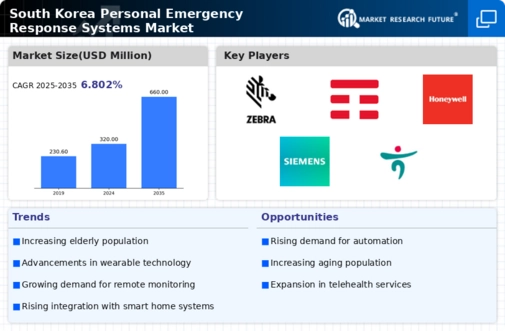Rising Health Awareness
The increasing health consciousness among the South Korean population appears to be a pivotal driver for the personal emergency-response-systems market. As individuals become more aware of health risks and the importance of immediate medical assistance, the demand for personal emergency-response systems is likely to rise. This trend is particularly evident among older adults, who are more susceptible to health emergencies. According to recent data, approximately 15% of the population is aged 65 and above, a demographic that is increasingly seeking solutions to enhance their safety and well-being. The personal emergency-response systems market is positioned to benefit from this heightened awareness, as consumers prioritize products that offer peace of mind and prompt access to emergency services.
Increased Focus on Elderly Care
The growing emphasis on elderly care in South Korea is a crucial driver for the personal emergency-response-systems market. With a significant portion of the population aging, families and caregivers are increasingly seeking solutions that ensure the safety and well-being of elderly individuals. This trend is reflected in government initiatives aimed at improving healthcare services for seniors, which may include subsidies for personal emergency-response systems. As a result, the market is likely to experience heightened demand, with projections indicating a potential growth rate of 15% over the next five years. The personal emergency-response-systems market is thus well-positioned to cater to the needs of this demographic, offering tailored solutions that enhance their quality of life.
Urbanization and Lifestyle Changes
Rapid urbanization in South Korea is reshaping lifestyles and, consequently, the personal emergency-response-systems market. As more individuals move to urban areas, the pace of life accelerates, leading to a greater need for reliable emergency response solutions. Urban dwellers often face unique challenges, such as increased traffic and higher incidences of accidents, which necessitate immediate access to emergency services. The personal emergency-response-systems market is likely to expand as urban residents seek systems that can provide quick assistance in critical situations. Furthermore, the convenience of urban living may drive the adoption of mobile emergency-response applications, further propelling market growth.
Rising Incidence of Chronic Diseases
The increasing prevalence of chronic diseases in South Korea is emerging as a significant driver for the personal emergency-response-systems market. Conditions such as diabetes, heart disease, and respiratory issues require constant monitoring and immediate intervention during emergencies. As the population ages and lifestyle-related health issues become more common, the demand for personal emergency-response systems is expected to rise. Recent statistics indicate that nearly 30% of adults in South Korea are living with at least one chronic condition, underscoring the necessity for reliable emergency response solutions. The personal emergency-response-systems market is likely to expand as healthcare providers and patients recognize the importance of having immediate access to emergency services.
Technological Integration in Healthcare
The integration of advanced technologies into healthcare services is significantly influencing the personal emergency-response-systems market. Innovations such as wearable devices, mobile applications, and telehealth services are enhancing the functionality and appeal of emergency-response systems. For instance, the incorporation of GPS tracking and real-time health monitoring features allows users to receive timely assistance during emergencies. This technological evolution is expected to drive market growth, as consumers increasingly favor systems that offer seamless connectivity and enhanced user experience. The personal emergency-response systems market is expected to see a surge in demand as these technologies become more accessible and affordable, potentially increasing market penetration by up to 20% in the coming years.















Leave a Comment